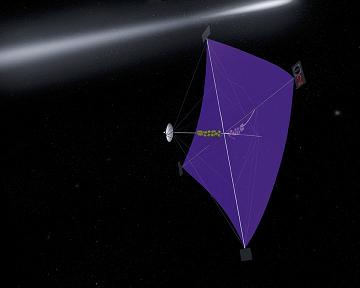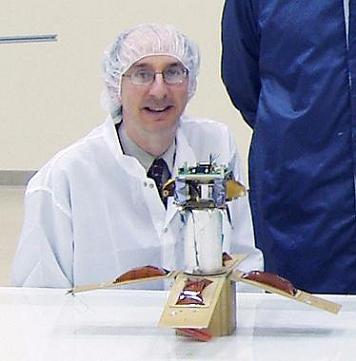Solar sails have emerged as a revolutionary propulsion system for space travel. Due to increased interest in both theoretical and experimental research, the benefits of solar sailing have become clear and compelling.
Two leading experts in solar sail propulsion, Gregory Matloff and Les Johnson, have agreed to share their knowledge about this exciting topic with OrbitalHub readers.
Gregory Matloff teaches physics at the New York City College of Technology and consults for NASA’s Marshall Space Flight Center. Les Johnson is a physicist at NASA’s Marshall Space Flight Center, where he serves as the Deputy Manager of the Advanced Concepts Office.
DJ: From the whole range of space technology-related fields of research, why was it that solar sails attracted your attention?
Gregory Matloff: I was attracted to solar sailing because it is an example of space propulsion that requires no fuel. As such, it has the potential to achieve higher velocities at less cost.
Les Johnson: They are simple, elegant and very practical in that they do not require any fuel. We are extremely limited in our exploration of space because of our lack of efficient propulsion. Sails, which require no fuel, will enable some science and exploration missions that are currently impossible (using only chemical rockets).
DJ: In the Solar Sails book, you have presented the problems and limitations of chemical, nuclear, and ion rocket propulsion. Why do you think that, despite these limitations, the solar sail has not yet been adopted as a means of propulsion for interplanetary robotic missions?
G.M.: Solar sails have been slower to achieve operational readiness for a number of reasons. First, space agencies have developed vast rocket-based infrastructures. We simply have more experience with rockets. Second, rockets work on Earth as well as in space. We needed a lot of in-space experience before sail testing in space could begin. Third, space-mission planners are a conservative lot. They (correctly) will not risk their payloads to a sail until the technological readiness of solar sailing is sufficiently advanced.
L.J.: The reasons are simple. 1) Any mission conducted in space is expensive. When you are the owner of a multi-million dollar spacecraft, you tend to become very conservative and risk averse. Even though there are many benefits to be gained from using a solar sail, it is new and therefore risky. We’ve flown hundreds, if not thousands, of rocket engines and not a single solar sail. Would you risk your investment on a new (risky) propulsion system? 2) Anytime you use a new technology, the first flight will be more expensive. If you are paying for a space mission and your budget is limited, you must often choose between what is best (like a solar sail) and what is good enough (like the tried and true rocket engine). Tried and true seems to be the choice right now.
Let me be clear. This may be penny wise but it is pound foolish. If solar sails become an “off the shelf” option like some rocket engines, then we will be going new places and learning things that we simply cannot otherwise accomplish with “tried and true” technologies.
DJ: How many solar sail designs have been considered to date, and which one do you think will prove to be the most successful in the future?
G.M.: There are six or seven different sail designs. These include rectangular (or square), spinning-disc, heliogyro, parachute, hollow-body, parabolic and hoop sails. All these and various other configurations may find application to different missions.
L.J.: There is no clear answer here. NASA and DLR selected the square, 3-axis stabilized approach. The Russians, with their Znamya, appear to prefer a spinning solar sail. Others prefer the heliogyro. All appear to be feasible.
DJ: How well suited is the solar sail for manned space missions?
G.M.: Unfurled near Earth, solar-sails are slow to accelerate but can reach high velocities. Current Earth-launched sail designs could be uprated and enlarged to carry freight to support manned interplanetary expeditions. Future thinner, heat-tolerant and radiation resistant solar sails manufactured in space could result in faster interplanetary transfers and even slow interstellar travel.
L.J.: Any solar sail that we can foresee building in the near term will be useful only for robotic missions. These sails will be big enough — some nearly half a mile on a side! To get the materials and sizes required for a human mission will require advances in materials technology that are difficult to imagine happening anytime soon. Though I am optimistic that they will eventually occur, we prefer the incremental approach. We should begin with using sails to propel robots and move toward a capability for humans.
DJ: How do you think space propulsion systems will evolve in the near future? To what extent will they include solar sails?
G.M.: Future solar-sail evolution requires advances in space infrastructure — notably in-space manufacturing, and materials science. More theoretical work on space environment effects and theories of devices such as the perforated solar sail is also required. Also, space-based solar-pumped lasers could be developed to allow sail acceleration farther from the Sun.
L.J.: I believe we won’t be giving up chemical rockets anytime soon. We will see more and more flights of solar electric propulsion after the (assumed) success of the DAWN mission, which is currently enroute to asteroids Ceres and Vesta. THEN we might see the use of solar sails begin.
Les Johnson and Gregory L. Matloff are two of the co-authors of the book Solar Sails: A Novel Approach To Interplanetary Travel. A good review of the book was written by Paul A. Gilster of Centauri Dreams. I invite everyone to read it.













 Subscribe to our RSS feed
Subscribe to our RSS feed










There are no comments.
Add A Comment